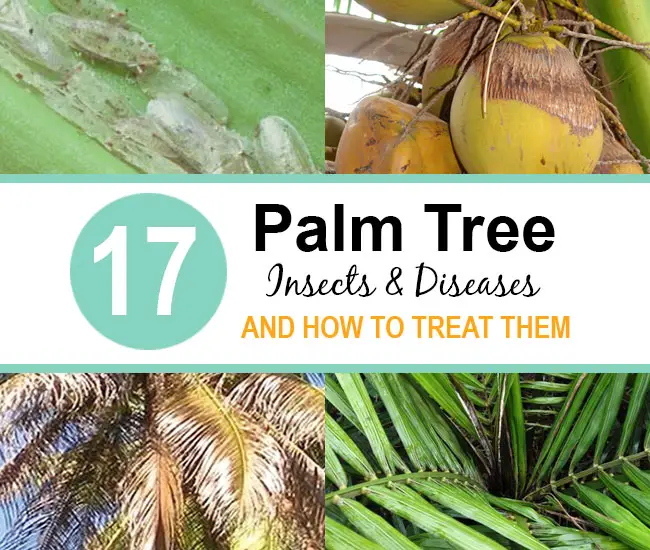
When compared to many other plants, healthy and well-grown palm trees generally experience fewer disease and pest issues.
That’s why it’s crucial to prevent any damage to the palm, especially during transportation. Cold or freeze damage is another common cause of harm to palms, which can attract unwanted insects and diseases.
This post will help you in identifying and treating the most common insect pests and diseases affecting palm trees.
1. Palm Aphids
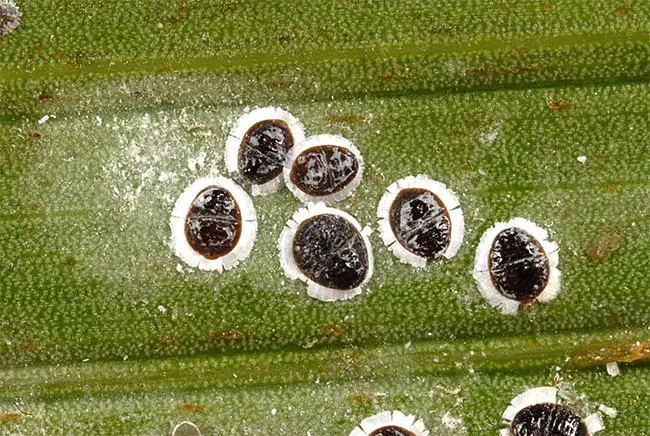
Originating from Southeast Asia, palm aphids primarily infest the newest growth and occasionally target young fruits. These sap-sucking insects can rapidly multiply on a palm tree.
Resembling whiteflies or scale insects, palm aphids measure approximately 1-2 mm in length. They sport an oval, dark brown body with a ring of white wax surrounding them. Despite their seemingly immobile appearance, they can persistently feed on the plant.
Similar to mealybugs, palm aphids excrete honeydew, which serves as nourishment for sooty mold fungus. This honeydew also attracts ants that protect the aphids and consume the sweet substance.
Palm aphids can attack various palm species, but they are frequently found on Chinese Fan Palms, Coconut Palms, Date Palms, Washington Palms, and Alexander Palms
Treatment
To address palm aphid infestations, use insecticidal soap or horticultural oil. Keep in mind that these products only eliminate pests on contact, so you may need to reapply as necessary. A reliable choice is insect-killing soap by Safer Brand.
This organic product, comprising potassium salts of fatty acids, effectively combats a wide range of insects, including aphids, earwigs, grasshoppers, harlequin bugs, leafhoppers, mealybugs, mites, plant bugs, psyllids, sawfly larvae, soft scales, spider mites, and whiteflies.
Consider using lady beetles as a natural method for palm aphid control and avoid applying soap to them.
2. Palm Leaf Skeletonizer
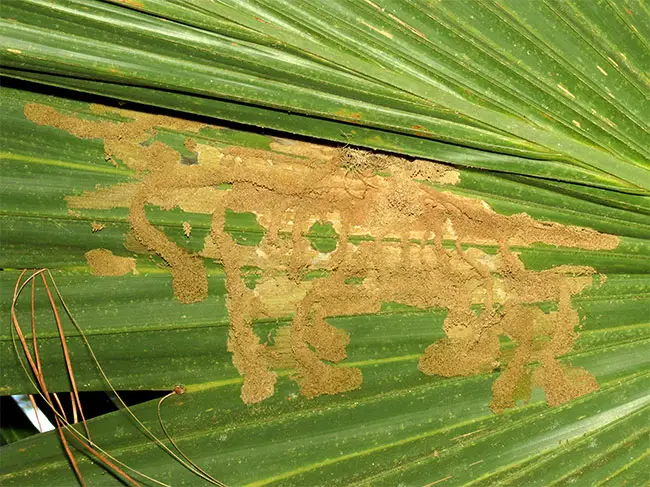
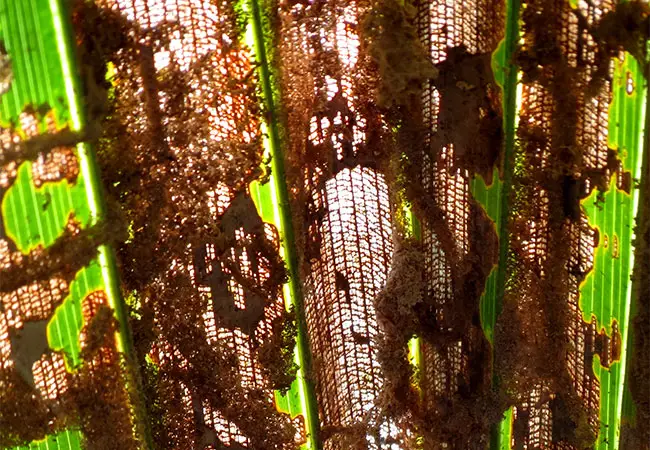
The palm leaf skeletonizer is a small caterpillar that feeds in large numbers on both sides of palm leaves.
It consumes the palm leaf tissue between the veins or ribs, resulting in the formation of dark tube-like structures resembling leaf skeletons.
Treatment
It’s crucial to spot these pests early and eliminate them before they can cause substantial damage. Use a high-pressure hose to wash away the larvae until they are completely gone.
If the infestation is severe, remove the affected fronds and thoroughly wash the remaining ones. For more effectiveness, consider spraying with an insecticide containing carbaryl or a biological insecticide.
3. Mealybugs
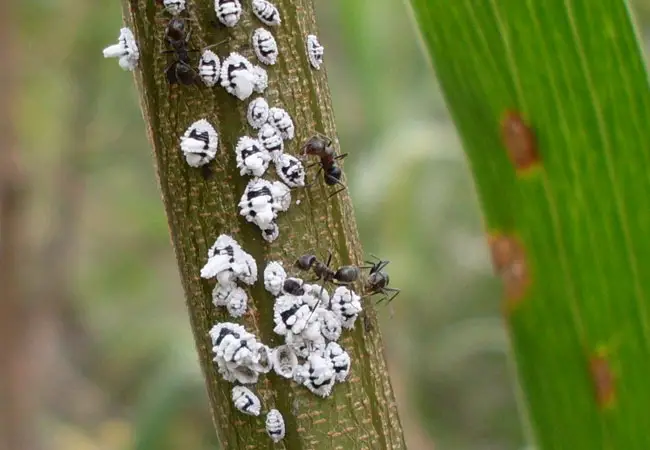
Mealybugs, belonging to the Pseudococcidae family, are unarmored scale insects typically found in moist, warm climates. Female mealybugs feed on plant sap, primarily targeting the palm bud but occasionally affecting the roots. Males are short-lived, serving only to fertilize the females.
Mealybugs attach themselves to plants, producing a powdery wax that provides protection and gives them their name. While a single mealybug won’t harm your plant, they reproduce rapidly, forming large colonies.
In severe infestations, mealybugs can potentially kill a plant by draining its juices. Additionally, mealybugs produce honeydew, a sticky substance that serves as food for sooty mold fungus. This honeydew attracts ants, which don’t harm the palm but protect the mealybugs and consume their honeydew.
Treatment
One effective method is to gently rub your plant with a mixture of soapy water and alcohol. Create a solution by mixing equal parts alcohol and water, adding some dish soap, and then use it to wash the entire palm.
This should help slow down the mealybugs. For complete mealybug eradication, I recommend using insecticidal soap.
4. Palmetto Weevil
Native to Florida, the Palmetto Weevil is a sizable beetle primarily attracted to severely injured and dying palms. It can also target newly transplanted palms experiencing stress, such as the Cabbage Palm and Canary Island Date Palm.
Recent studies from the University of Florida have revealed that it can even infest entirely healthy palms like the Canary Island Date, Bismarck, and Latan palms.
Palmetto Weevils exhibit a range of colors, from black to entirely red, and their size varies from 1.9 to 3.0 cm. Adult weevils lay their eggs in the leaf bases, which hatch into large, creamy to yellowish larvae.
It takes approximately three days for the eggs to hatch, and the larvae begin feeding on the plant. As they grow, they tunnel into the palm’s heart, where they continue to feed and eventually create cocoons from which adult weevils emerge.
Over time, this pest destroys the palm’s heart, leading to the death of the tree. Symptoms may not become noticeable until the leaf crown collapses.
Treatment
To minimize the risk of a palmetto weevil attack, focus on reducing transplant stress in newly planted palms. Detecting a weevil infestation before significant damage occurs to the palm’s bud can be challenging.
If you spot them early, treat the palm with insecticidal soap. Unfortunately, in many cases, the only option is to remove the infected palm before adult weevils emerge.
5. Saddleback Caterpillar
The Saddleback Caterpillar, which feeds on the underside of palm leaves, creates large holes in the foliage. This caterpillar has a dark brown body adorned with distinct, bright green patterns on its back, resembling a saddle, hence its name, “saddleback caterpillar.”
It possesses poisonous spines that can cause a burning sensation similar to a bee sting when touched with bare hands. You can find them on the following palm tree varieties: Alexander, Christmas, Fishtail, Coconut, Princess, Butterfly, Mazari, Canary Island, Pygmy Date, Queen, and Mexican Fan palms.
Treatment
To control young caterpillars, use biological insecticides, and always remember to wear gloves to protect your skin.
6. Scale Insects
If you discover numerous small, circular, brown-colored scales on your palm tree, you have cause for concern. These are known as “palm leaf scales,” and they can pose a serious threat. Common scale insects that infest palms include the Florida red scale, thread scale, Magnolia white scale, and soft brown scale.
Interestingly, palm leaf scales are actually mature female insects. They appear as small, headless, legless bumps and once they reach maturity, they become immobile, firmly attached to where they’ve settled. These small brown bumps often concentrate on new fronds.
Palm leaf scales damage palm trees by inserting a straw-like appendage into the palm and extracting its fluids. While a single scale may not harm a palm tree, their rapid multiplication can gradually lead to the palm’s demise. These scales are both common and detrimental to palms and can be quite challenging to get rid of.
Treatment
Eliminating palm leaf scales can be quite challenging, but it’s achievable. The typical treatment involves repeatedly spraying the palm tree leaves with horticultural oil or a mixture of equal parts rubbing alcohol and water, combined with a bit of dish soap.
If you have the patience, you can apply pure rubbing alcohol directly to each scale individually. Here’s how:
- Gather a small spray bottle, rubbing alcohol, and some dish soap.
- Create a mixture of equal parts rubbing alcohol and soapy water.
- Now, it’s time to thoroughly spray your palm tree.
This approach will slow down the scale population, and you’ll certainly notice a reduction in their numbers. However, keep in mind that they are resilient pests. To completely eradicate them, use a high-quality insecticidal soap.
Simply spray the entire palm with this solution once a week for a few weeks. The first treatment will eliminate immature scales and adults, but some eggs beneath their protective shells may survive. The second treatment should target the newly hatched crawlers and young scales.
7. Spider Mites
Spider mites, though not true insects, belong to the spider family. They tend to thrive on indoor plants or in dry conditions. While there are many species of spider mites that feed on palms, the most common one is the two-spotted mite.
Symptoms include yellow spotting or stippling on the leaves. In severe cases, the leaves may become pale or appear washed out, with webbing visible on the undersides. These mites are small, white, and move like tiny dots, often requiring a lens to spot.
Treatment
To eliminate spider mites, treat the palm with horticultural oil, insecticidal soap, or miticides.
8. Coconut Mite
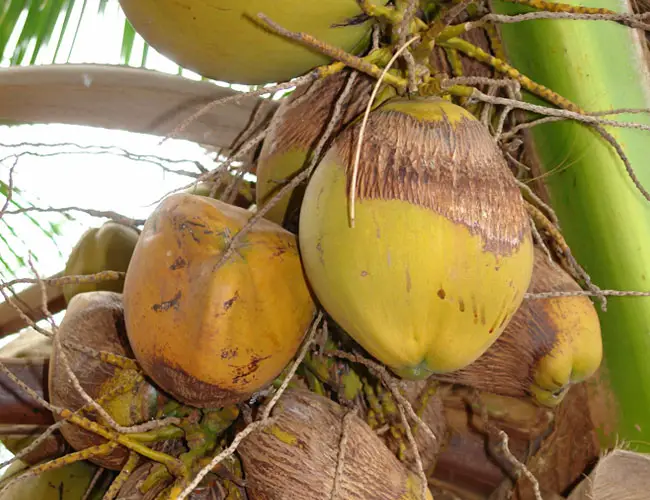
As the name suggests, this pest exclusively targets coconut palms. These tiny mites feed on the husk of coconut fruits, causing primarily cosmetic damage.
In cases of extremely large and dense populations, fruit distortion and premature fruit drop may occur.
Treatment
Due to their small size, coconut mites are challenging to detect, and even after detection, eliminating them with chemicals is quite difficult.
As a result, most palm owners opt to prune all coconuts in various stages of development.
9. Royal Palm Bug
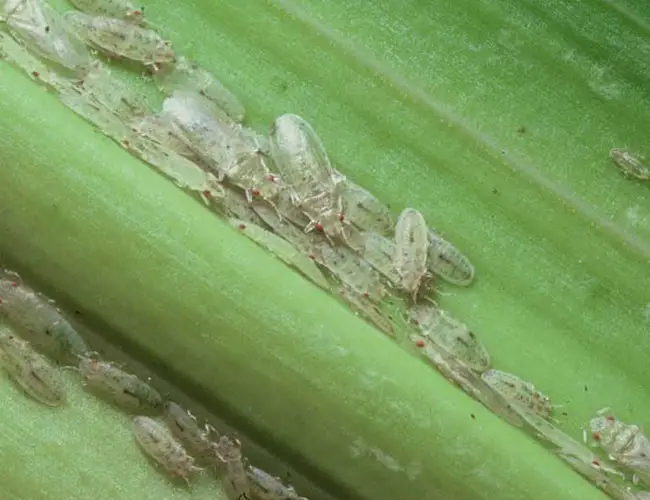
This bug, native to Florida and Cuba, exclusively attacks Royal palms. These tiny, yellow-green insects feed on the young palm leaves, with female bugs depositing their eggs between the folds of newly emerging leaflets.
After 8-9 days, the eggs hatch, and when the leaf unfolds, it often appears scorched and brown, typically failing to mature. While these bugs rarely kill the palm, they can inflict significant damage.
Treatment
The most effective way to combat this pest is by applying an insecticide spray. If the palm is too tall to spray without special equipment, consider drenching the soil at the first sign of an infestation.
10. Leaf Spots
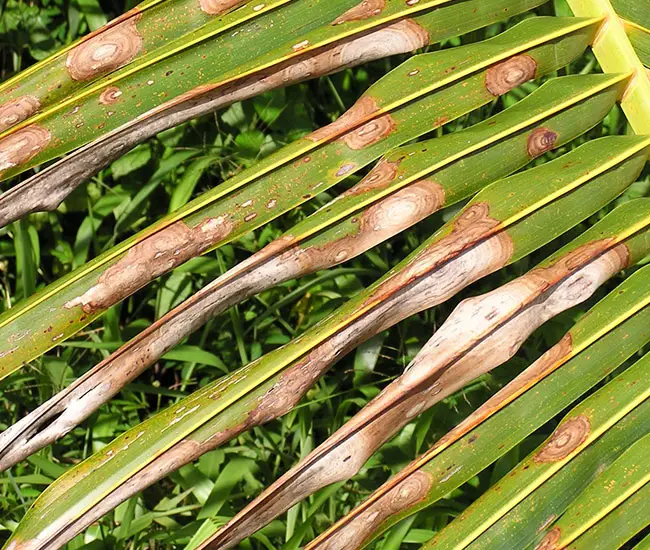
Leaf infections known as “leaf spots” are caused by various fungi and some bacteria and can affect many types of trees. Leaf spots can manifest as circular to elongated, brown, and potentially oily-looking marks.
The size and color of these spots can vary depending on the plant, the type of organism causing the infection, and the stage of development. Distinguishing between different leaf-spotting fungi based solely on visual symptoms can be challenging.
Leaf spots typically develop as a secondary issue on nutrient-deficient palms or those that have sustained damage.
Treatment
Don’t water the palm leaves directly. In most cases, leaf spots won’t be fatal to the palm tree, and using fungicides is generally unnecessary.
If the damage becomes severe, fungicidal sprays containing copper hydroxide or copper salts of fatty acids can be considered. If only a few fronds are affected, it’s often easier to remove them.
11. False Smut
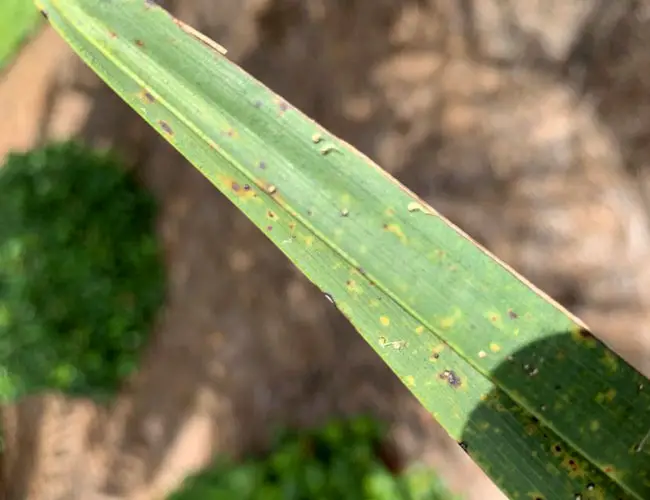
False smut, also known as Graphiola leaf spot, is caused by Graphiola species. This disease is most prevalent in areas with high humidity.
It presents as small, black, wart-like structures, often with yellow filaments protruding from the center of the raised spots.
Both sides of the leaf can be affected. A high incidence of this fungus on leaves can lead to premature death of older leaves, although usually, there are no symptoms on the youngest leaves. While this is a common disease of date palms in South Texas, chemical control is rarely necessary.
Treatment
Ensure proper spacing between palm trees to allow for ample air circulation, reducing humidity. During irrigation, getting the fronds wet. Removing and disposing of severely infected palm fronds can help minimize the spread of disease.
However, it’s important to note that removing too many fronds can be more detrimental to the palm tree than the disease itself. Palm trees are sensitive to nutritional deficiencies, and excessive frond removal can exacerbate existing problems and weaken the tree.
Fungicides are typically unnecessary but can be applied preventatively in the spring. Choose a fungicide containing copper hydroxide or copper salts of fatty acids. If palm trees are used for food purposes, copper fungicides are the only approved option.
12. Sooty Mold
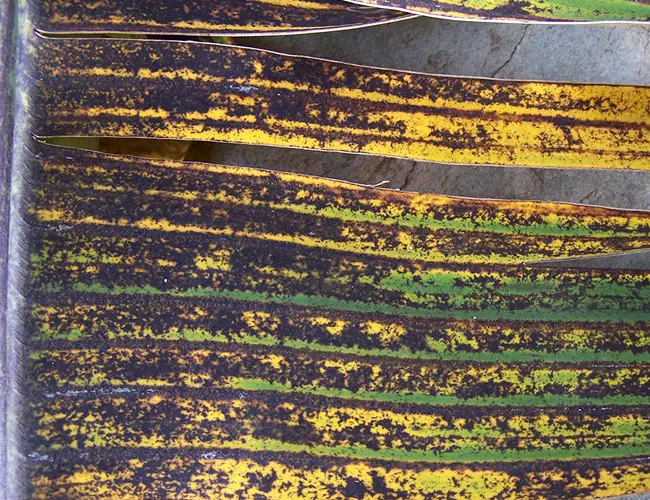
This superficial fungal disease often thrives on honeydew produced by infestations of mealybugs, palm aphids, and scale insects, resulting in a black coating on the leaves. It’s consistently associated with an infestation of these insects.
Treatment
Sooty mold appears on the leaf surface, and sometimes on the trunk. It does not directly harm the plant and can be easily washed off.
To prevent the issue from recurring, it’s essential to control the sucking insects responsible for producing honeydew.
13. Bud Rot
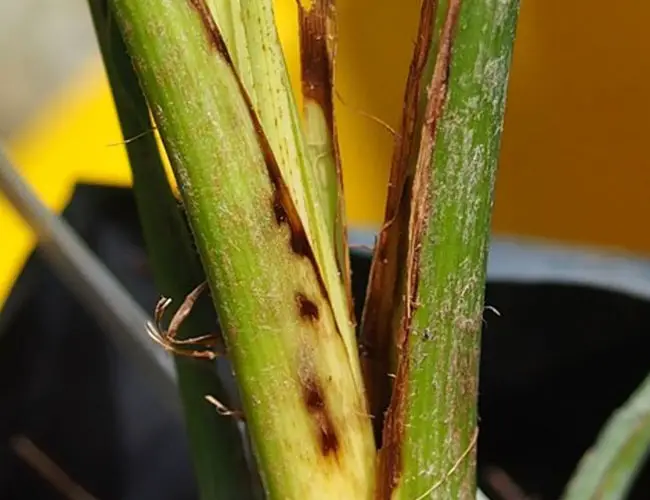
This common disease is typically encountered in palms during hot, wet summers. While bud rot tends to develop after a tropical storm or periods of excessive rain, bacterial bud rot usually occurs when the bud has been damaged by cold weather.
Regardless of the pathogen, the disease presents similar symptoms. The new frond becomes discolored and wilts, followed by discoloration of the next newest leaves. Black lesions may also appear on the new palm spears, leading to the rotting of the bud.
Over time, this area may become slimy and attract secondary invaders. Older palm tree fronds may remain green for several months and are the last to die off, leaving only the trunk behind.
Treatment
In the early stages, drenching the bud with a fungicide containing fosetyl-Al, propamocarb, or mefenoxam can be effective. Whenever possible, avoid overhead irrigation.
If the new spear can be easily pulled out and the next newest one is already brown, it may be too late to save the palm. Infected palms should be promptly removed and destroyed to reduce the spread of the disease.
14. Ganoderma Butt Rot
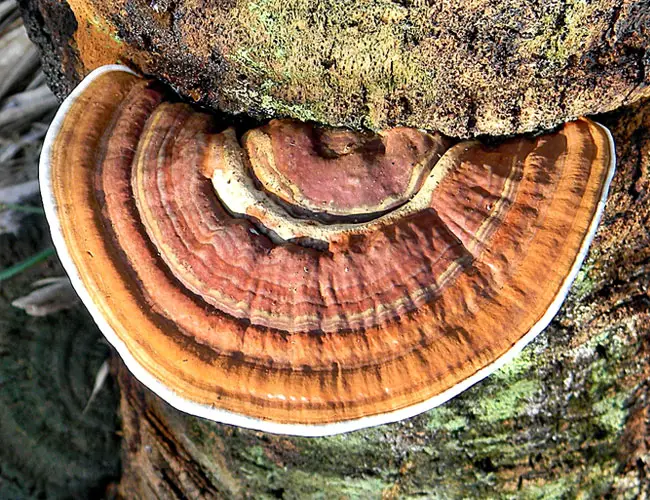
This disease is caused by the fungus Ganoderma zonatu, which can infect various types of palm trees. It primarily targets older palm trees that are 15 years or more in age. The initial sign of infection is the withering and drooping of the older fronds.
As the disease progresses, the fronds collapse and droop parallel to the trunk. New growth becomes stunted, appearing pale green or yellow in color.
In severe cases, the head of the infected palm tree may fall off, or the trunk itself may collapse. Depending on the point of invasion, palm tree roots can experience significant decay.
While the outer trunk tissues may seem solid, affected palms produce a hollow sound when tapped. Upon dissecting the trunk, areas of dark brown tissue become evident. Over time, conks (spore-producing structures of the fungus) may develop.
These conks appear as white, spongy growths at the lower portion of the trunk (the butt of the tree, hence the name “Butt Rot”), turning brown as they mature.
The death of a palm tree from Ganoderma Butt Rot can take three to four years, depending on the tree’s age and environmental conditions.
Treatment
Since this fungus survives on plant tissue, it’s crucial to remove and destroy any root systems, stumps, and trunks of dead palms in the landscape. Removing the conk will prevent spores from spreading to other trees.
Because Ganoderma survives in the soil, it is not recommended to plant another palm tree in the same location. Unfortunately, there is no chemical control available for this disease.
To prevent injury to palm trees, especially during planting, staking, and regular maintenance activities involving string trimmers and lawnmowers, exercise caution and care.
15. Lethal Yellowing
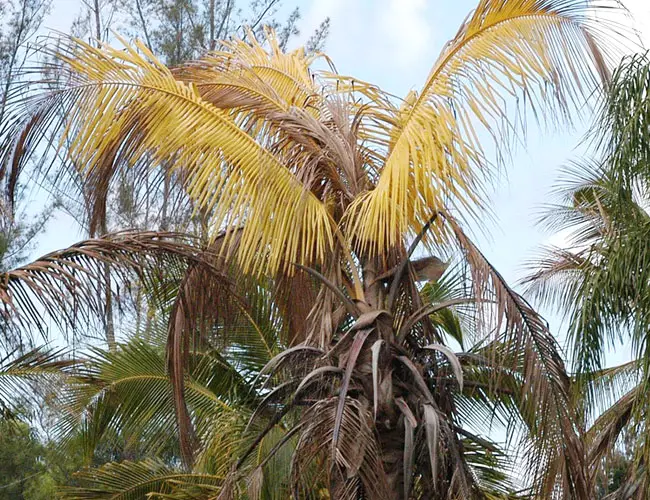
Lethal Yellowing is a deadly disease caused by a mycoplasma-like organism, a bacterium lacking cell walls. It is commonly transmitted by a sucking insect known as Myndus crudus.
After feeding on an infected palm, the leafhopper bug moves to a healthy one, thereby transmitting the disease. The first signs of the disease include the blackening of young flowers and fruit stems, followed by premature fruit drop.
On most palms, the older leaves will initially turn yellow, grey, or brown, leading to the wilting and eventual death of the entire canopy.
Treatment
Unfortunately, there is no cure for lethal yellowing. Periodic injections of antibiotics can help prevent its progression, but if treatment is discontinued, the palm tree will inevitably succumb to the disease.
16. Fusarium Wilt
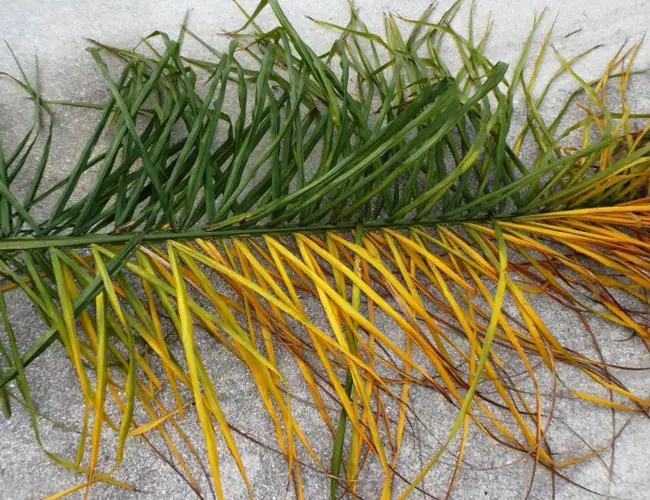
This fungal disease, native to California, has now also been found in Florida. On infected palms, the leaflets on only one side of the leaf stem of the oldest leaves begin to turn brown and eventually die.
The fronds develop a reddish or dark brown strip along the leaf stem. Over time, all old leaves turn completely brown, and the disease progresses to the newly emerging fronds.
It can take from a few months to two years for the palm to be overwhelmed by Fusarium wilt and die. Coconut palms, Mexican palms, and Date palms have been the most severely affected by this disease.
Treatment
There is no treatment available for this disease, but it can be prevented from spreading to other palms by disinfecting pruning tools between trees.
17. Bacterial Bud Rot
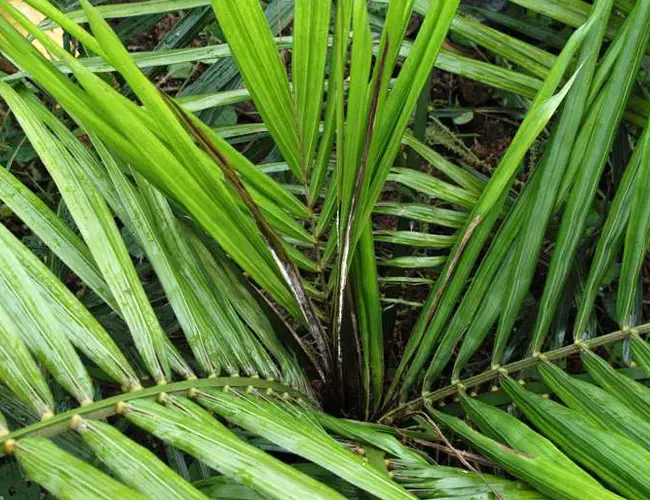
Bacterial Bud Rot causes a wet blight of the emerging spear leaf, which can then spread downward to the bud. The affected leaf spear often detaches easily from the bud, and a foul odor may be present. This disease typically affects palms that have been damaged by cold weather.
Treatment
Bud drenching with copper-based fungicides can be effective in managing this disease. It’s best to apply it before the onset of cold weather.
Final Thoughts
In general, insects and diseases tend to target weakened trees. Healthy palms have a natural resistance to insect pests and diseases. Therefore, maintaining proper nutrient levels and providing winter protection are essential for keeping your palm healthy.
Of course, it’s always better to detect insects and diseases in their early stages before they become fatal. Look for signs such as new growth that has died back or fronds that appear discolored, spotted, or frizzled. These signs indicate that something is amiss with your tree.
One of the products I use against various types of fungi is Copper Fungicide Spray by Bonide. It’s an excellent fungicidal spray that effectively controls many diseases, including powdery mildew, downy mildew, black spot, peach leaf curl, rust, and others.
For insecticidal soap, I prefer Safer Brand Insect Killing Soap. This spray has consistently worked for me against a wide range of insects, including aphids, earwigs, grasshoppers, harlequin bugs, leafhoppers, mealybugs, mites, psyllids, sawfly larvae, soft scales, spider mites, squash bugs, blossom thrips, and whiteflies. Its organic formula helps eliminate harmful insects while sparing beneficial ones.
Related articles:
–Expert Tips: How to Save a Dying Palm Tree Fast
–Top 10 Palm Tree Planting Mistakes You Don’t Want To Make
–5 Most Common Nutrient Deficiencies In Palms (with Pictures)
–Expert Tips: How And When To Fertilize Palm Trees
–5 Steps To Saving Freeze Damaged Palm Tree

I have a tall palm tree that has an area about 4 feet of a thin brown mudish material that is as think as posterboard and flakes off. Any idea
Please Help. Cracks in Trunk – Syagrus romanzoffiana
What is the problema ???
I have something boring wholes in the trunk of my Queen palm. What is it and what do I do about it?
Thank you,
Toni
Jacksonville, fla.
palm tree sway with climber to trim he said bad tree needs cut down?
I found white foamy substance on my potted palm tree on the top leaf and a couple of lower branches.
I washed these branches off with warm soapy water.
Does this have something to do with all of the rain we are having and the high humidity?
MY COCONUT PALMS HAVE A BLACK SOOT ON THE LEAVES. WHAT CAN I APPLY TO CLEAN IT UP.
MY COCONUT PALMS HAVE BLACK SOOT ON THE LEAVES. HOW DO I CORRECT THIS?
My windmill palm has an issue and I don’t know what it it is. Some of the leafs are brownish and look dead although, are not. I don’t think it lethal yellowing. But I can find anything that resembles what my Palm has. Any way I can submit a photo for diagnosis?
Hi I have some type of bug growing on my Mexican palm trees. It look like a small little Brillo pad, about a quarter to one half inch. They are yellowish and have a small little yellow bug in the center that’s like alittle yellow tab. I had them before Hurricane Ike came through and now years later they are back! Any idea what they could be? They are on the leaves.
Any help or answers would be much appreciated.